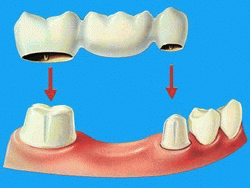Crowns

Crowns can also return full dental function and relieve unexplained pain due to hairline cracks in teeth. In front teeth, older fillings can both weaken the teeth and cause staining or chipping. Porcelain crowns and bridges are suitable in cases where porcelain veneers are not. In teeth with root canal fillings, crowns can prevent breakage.
When taken care of properly, these treatments typically last 20 to 30 years – as close to permanent as any dental treatment gets.
How long does it take?
Fitting a crown typically requires two visits to our office. During the first visit Dr. Zeng will remove decay, shape the tooth, take an impression for the permanent crown and fit it with a temporary plastic crown. We schedule an hour and forty minutes for this appointment but may be longer if other treatment, such as a crown build-up, is also performed at the same time.
During your second visit, approximately 2 weeks later, we will remove the temporary crown, then fit, adjust and permanently place (or seat) the final crown resulting in a new, natural looking tooth. We schedule about forty minutes for this appointment.
Bridges
All of your teeth play an important role in speaking, chewing and maintaining proper alignment of other teeth, not to mention your appearance, so it is vital to replace any that are lost. A bridge is a device used to replace missing teeth, and attaches artificial teeth to adjacent natural teeth, called abutment teeth. Bridges can be attached permanently to the teeth. They are bonded into place and can only be removed by a dental professional.
Why do I need a bridge?
Restoring oral functionality is the most important reason for a bridge. Teeth are naturally designed to support each other. When teeth are missing, unusual stress is placed on the gums and other oral tissues, and there is a high risk of developing gum disease and a number of other potentially harmful disorders. A bridge can help prevent these problems when natural teeth are missing. A bridge will also help prevent the teeth from shifting. When there is a missing tooth resulting in a space, the teeth adjacent to the space may drift, and the tooth above or below the space may move as well.
Appearance is another important reason for wearing a bridge, which helps to support your lips and cheeks. A missing tooth may cause your mouth to sink and your face to look older. Missing teeth can also cause speech disorders since they are used to make many of the sounds we use to speak clearly.
How is a bridge attached?
Constructing and attaching a bridge typically requires two or three appointments. At the first appointment we will prepare the teeth on either side of the gap by removing a portion of the enamel and dentin. Since the bridge must be fabricated very precisely to ensure correct bite and to match the opposing tooth, impressions of the teeth are taken and sent to a lab where the bridge will be constructed. Fixed bridges are typically cemented to the natural teeth next to the space left by the missing tooth. A pontic (false tooth) replaces the lost tooth. Crowns, which are permanently attached to your natural teeth, provide support for the bridge.
What materials are used?
Bridges can be constructed from gold alloys, non-precious alloys, porcelain, or a combination of these materials. Porcelain is often bonded to either precious or non-precious metal. Our lab chooses which material will be best for your bridge once they receive your impressions.
How do I take care of my bridge?
A strict regimen of brushing and flossing will keep the bridge and surrounding teeth clean. Floss threaders will assist in cleaning around and underneath the bridge. This is vital part in taking care of your bridge, since the bridge relies on the neighboring teeth for support.

